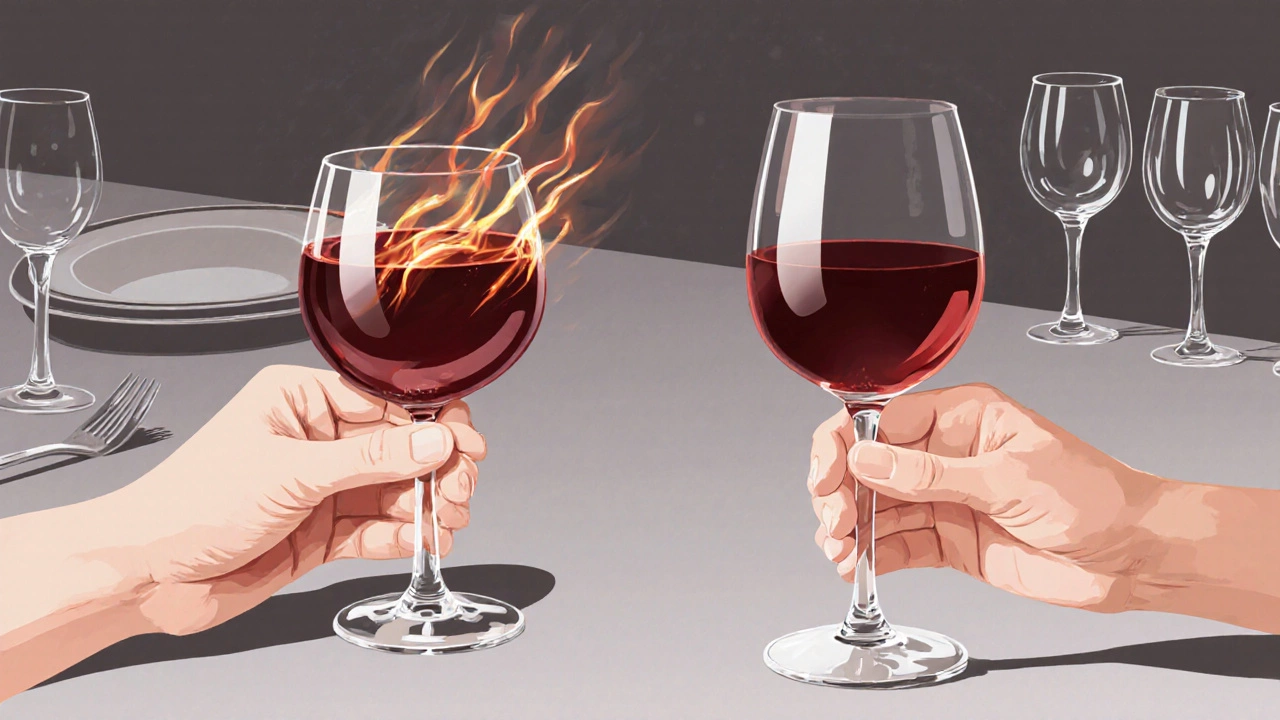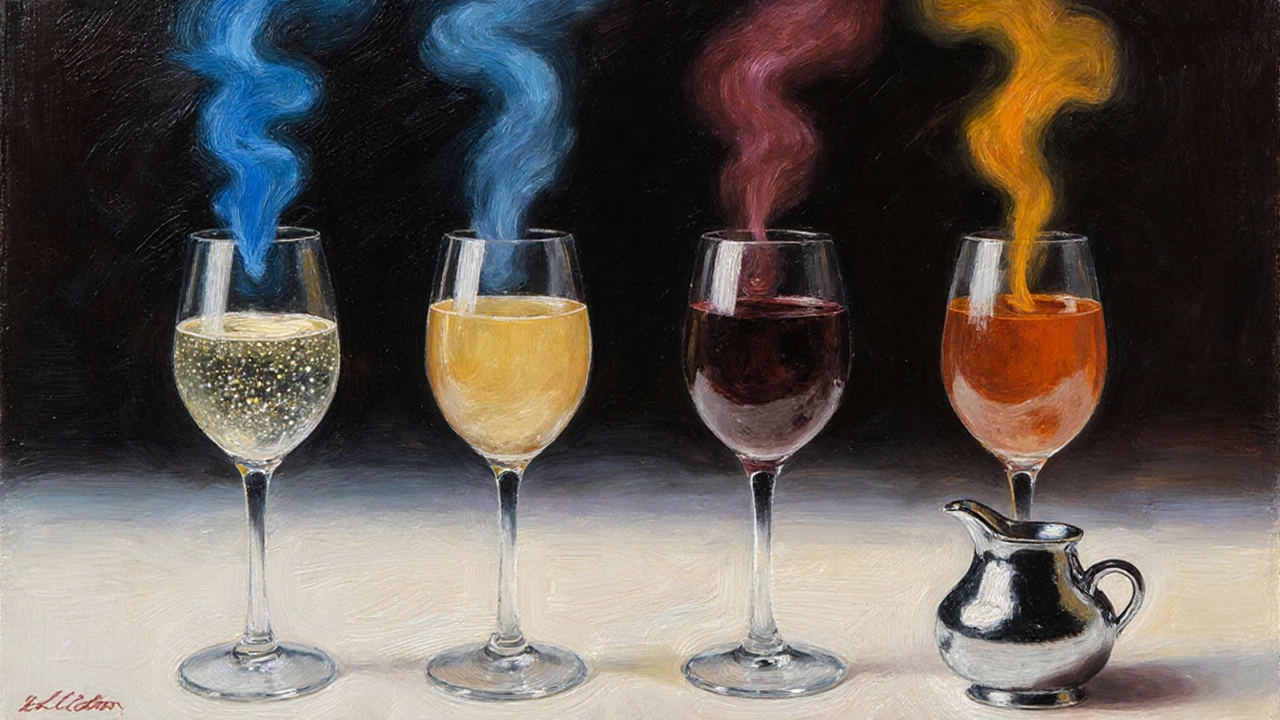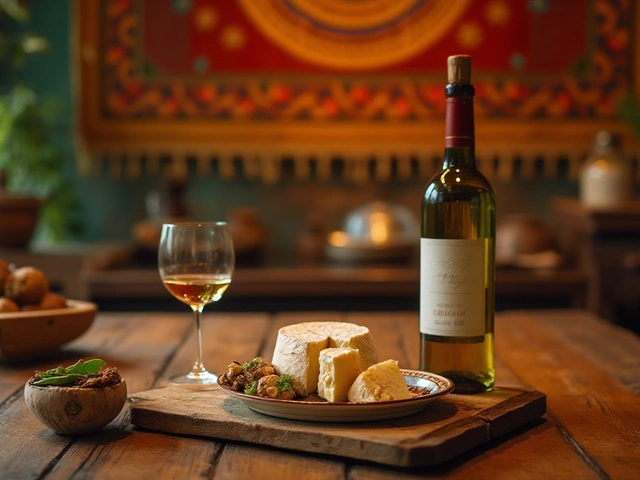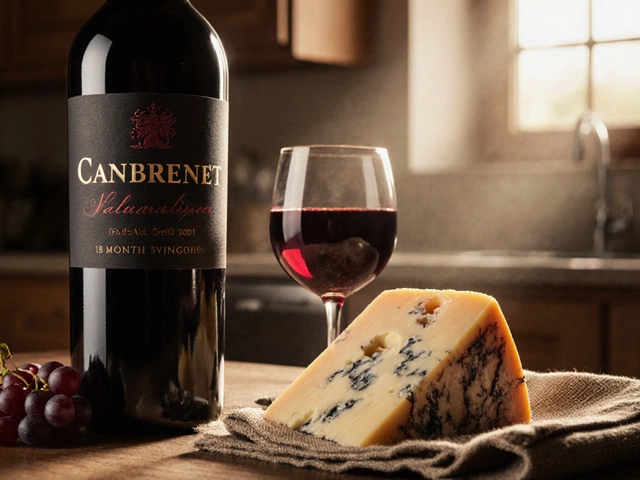
Wine Serving Temperature Calculator
Find the ideal serving temperature for your wine. Correct temperature is crucial for taste, aroma, and texture.
Wine isn’t just a drink. It’s a living thing. Open a bottle too soon, hold the glass wrong, or pair it with the wrong food, and you’re not just wasting money-you’re missing out on layers of flavor, aroma, and history that took years to develop. You don’t need to be a sommelier to enjoy wine, but you do need to avoid the mistakes most people make without even realizing it.
Don’t Store Wine Like a Soda Can
Wine doesn’t like sunlight, heat, or noise. Storing it on a kitchen counter near the toaster, in a bright cabinet, or on a shelf above the fridge? That’s how you turn a $50 bottle into vinegar. Light, especially UV rays, speeds up oxidation. Strong smells-from cleaning products, onions, or even paint-can seep through the cork and taint the wine. Temperature swings are worse. If it’s 10°C one day and 28°C the next, the wine expands and contracts, pushing air in and out of the bottle. That’s bad for aging. And vibrations? Yes, even the hum of a washing machine or a fridge compressor can disturb the sediment and mess with chemical reactions inside the bottle.The fix? Find a dark, cool, quiet spot. A basement corner, a closet away from appliances, or even a wine fridge set to 12-14°C works. Red wine doesn’t need to be room temperature-it needs to be 16-18°C. White and rosé? 8-12°C. If you’re serious, invest in a wine rack that keeps bottles lying on their side. That keeps the cork moist so it doesn’t dry out and let air in.
Don’t Serve Champagne in a Regular Wine Glass
You’ve seen it: someone pours sparkling wine into a tall, narrow flute and calls it a day. That’s not wrong, but it’s not ideal either. Flutes are great for preserving bubbles, but they trap aromas. Champagne and sparkling wine are full of complex notes-baked apple, toasted bread, citrus zest-that you’ll never smell if the glass is too narrow.A better option? A white wine glass. Wider bowl, narrower rim. It lets the bubbles rise slowly while giving your nose room to catch the scent. If you’re tasting multiple sparkling wines, use the same glass for each so you’re comparing apples to apples, not flutes to coupes.
Don’t Hold the Glass by the Bowl
This is one of the most common mistakes-and it’s easy to do. You pick up the glass, wrap your fingers around the bowl, and take a sip. Sounds normal, right? But your hand is around 37°C. That heat transfers into the wine. Suddenly, your chilled white wine is warming up. Your delicate Pinot Noir starts to smell more like alcohol than fruit.Always hold the glass by the stem. If there’s no stem, hold it by the base. That’s it. No exceptions. Even if you’re at a backyard BBQ and everyone’s holding their glasses like beer mugs, you’ll notice the difference. The wine tastes fresher, cleaner, more alive.
Don’t Swirl Like You’re Trying to Make a Hurricane
Swirling is supposed to release aromas. It’s not a competition. Swirling too hard? You’ll splash wine everywhere. Swirling too little? You’ll miss the subtle notes-peach, wet stone, leather, smoke-that only come out when the wine gets oxygen.Do this: Rest the base of the glass on the table. Gently rotate your wrist in a small circle. One or two turns. Watch how the wine clings to the sides-those are the “legs,” and they tell you about alcohol and sugar content. Then sniff. Don’t just take one quick whiff. Breathe in slowly. Wait. Breathe in again. The wine changes with every sniff.

Don’t Pair Red Wine with Cheese (Unless You Know What You’re Doing)
The classic “red wine and cheese” combo? Often a disaster. Most red wines are high in tannins-those drying, grippy compounds from grape skins and oak barrels. Dairy? It coats your mouth and makes tannins taste harsher. That’s why a Cabernet Sauvignon with cheddar can leave your tongue feeling like sandpaper.Try this instead: Go for white or rosé with cheese. A crisp Sauvignon Blanc with goat cheese. A dry Rosé with brie. Even a light Pinot Noir with soft cheeses like camembert can work-but only if the cheese isn’t too fatty. If you’re set on red, pick one low in tannins: Gamay, Frappato, or a young Dolcetto. Or better yet, skip the cheese and pair your red with mushrooms, duck, or dark chocolate. Those flavors actually lift the wine.
Don’t Rush the Taste
Too many people take a sip, make a face, and say, “Not for me.” Then they move on. That’s like judging a person after one sentence.Wine opens up. It changes. A young Bordeaux might taste tight and bitter at first. After 10 minutes in the glass? It blooms-dark berries, tobacco, wet earth. A Tokaj dessert wine? It needs 20 minutes to reveal its layers of honey, apricot, and spice. That’s not magic. That’s chemistry.
Here’s what to do: Pour a small sip. Swirl. Smell. Sip again. Wait 30 seconds. Take another sip. Then, after you’ve tasted two or three other wines, come back to the first one. You’ll be shocked. What tasted harsh before now feels balanced. What seemed flat? Now it’s complex. Patience isn’t optional. It’s part of the tasting.
Don’t Taste in the Wrong Order
Tasting a bold Shiraz before a delicate Riesling? You’ll kill your palate. Heavy, high-alcohol, or sweet wines dull your sensitivity. Once you’ve had a Port, a Moscato, or a Zinfandel, everything else tastes thin and boring.Always go light to heavy:
- Sparkling wine
- Light whites (Sauvignon Blanc, Pinot Grigio)
- Full whites (Chardonnay, Viognier)
- Light reds (Pinot Noir, Gamay)
- Full reds (Cabernet, Syrah)
- Dessert wines (Port, Sauternes)
And if you’re tasting more than four wines? Spit. Yes, spit. It’s not rude. It’s professional. You’ll taste better, remember more, and avoid the headache that comes from drinking too much too fast.
Don’t Use the Same Glass for Everything
You don’t need a different glass for every grape, but you should avoid using a tumbler for Pinot Noir or a shot glass for Chardonnay. Glass shape matters. A wide bowl lets reds breathe. A narrow rim focuses the aroma of white wines. A tulip-shaped glass-wider at the bottom, narrower at the top-is the safest bet if you only have one type.Don’t overthink it. But do avoid thick-rimmed, cheap glasses. They distort the wine’s texture and make it harder to smell. If you’re buying one set, go for lead-free crystal. It’s thinner, clearer, and lets the wine speak.

Don’t Serve Wine at the Wrong Temperature
Red wine isn’t “room temperature” if your room is 22°C. That’s too warm. The ideal temperature for most reds is 16-18°C-like a cool autumn evening. Serve it too warm, and alcohol dominates. Too cold, and the flavors shut down.Whites and rosés? They’re often served too cold. Ice-cold masks acidity and fruit. Take them out of the fridge 15-20 minutes before serving. Chilled but not numb. Sparkling wines? Keep them in the fridge until the last minute. Serve them at 6-8°C. That’s when the bubbles are lively and the flavors bright.
Don’t Open Sparkling Wine Like a Firework
The loud pop? It’s theatrical. But it’s also wasteful. That sudden pressure release sends bubbles and liquid flying. You lose volume. You lose flavor. And you might get glass shards if the cork flies off wrong.Here’s the right way: Chill the bottle. Remove the foil and wire cage. Hold the cork firmly with one hand. Twist the bottle-not the cork-with the other. Let the pressure ease the cork out slowly. You should hear a quiet sigh, not a bang. If it pops, you’re doing it wrong.
Don’t Ignore the Aroma
Tasting wine without smelling it is like watching a movie with the sound off. The nose tells you 80% of what you’re going to taste. That’s why sommeliers spend so much time sniffing.Smell the wine before you sip. Then smell it again after you take a sip. Notice how the scent changes. That’s the wine revealing itself. If you smell nothing but alcohol, it’s too cold. If you smell vinegar or wet cardboard, it’s corked. If you smell fresh-cut grass, citrus peel, or wet stones? You’re in the right place.
Don’t Pretend You Like a Wine You Don’t
You don’t need to like expensive wine. You don’t need to pretend you taste “notes of blackberry and graphite.” If a wine tastes like vinegar to you, it probably is. If it’s too sweet, too sour, too bitter? Say so. Wine isn’t about impressing others. It’s about what you enjoy.Some people love bold, tannic reds. Others prefer crisp, floral whites. There’s no right answer. The only mistake is ignoring your own palate to follow a rule. Trust your nose. Trust your tongue. That’s the only rule that matters.
Should I always decant red wine?
No, not always. Decanting helps older reds with sediment and young, tannic wines that need air. But most everyday reds-like Merlot or Grenache-don’t need it. If the wine tastes fine straight from the bottle, skip the decanter. Decanting too early can make delicate wines lose their freshness.
Can I drink wine with ice?
Yes-if you want to. Ice dilutes wine and dulls its flavors, but if you’re in a hot climate and just want something refreshing, go ahead. Some people in Spain and Portugal drink chilled reds with ice in summer. It’s not traditional, but it’s not wrong. Just know you’re changing the experience, not fixing a bad wine.
How long can I keep an open bottle of wine?
Red wine lasts 3-5 days if re-corked and stored in the fridge. White and rosé last 5-7 days. Sparkling wine? Only 1-2 days, even with a stopper. Use a wine pump to remove air, or just pour the leftover into a smaller bottle to reduce oxygen exposure. The goal is to slow oxidation.
Is it okay to drink wine from a plastic cup?
Technically, yes. But you’re missing out. Plastic cups don’t let you swirl properly, trap aromas poorly, and often have a chemical taste. If you’re at a picnic or camping, fine. But for tasting, use glass. It’s the only material that doesn’t interfere with the wine.
What’s the best way to clean wine glasses?
Hand wash with hot water and no soap. Soap leaves residue that kills aroma. If you must use soap, use a tiny drop of fragrance-free dish soap and rinse thoroughly. Dry with a lint-free cloth. Never store them upside down on a rack-dust collects inside. Hang them or store them upright in a clean cabinet.





Categories